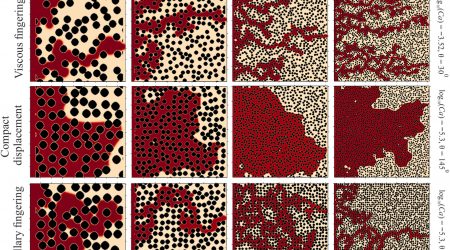Irek Mukhamatdinov on why oil is being recovered in the ocean

Senior Research Associate Irek Mukhamatdinov, winner of the 2023 Russian Presidential Award for Science and Technology, gave an interview to the National Projects of Russia YouTube channel. Here is a full transcript.
— Is it true that oil comes from dinosaurs?
— There are two theories of the origins of oil – organic and inorganic. Dmitry Mendeleev believed that iron carbide in soil reacted with water and thus produced a large quantity of hydrocarbons. However, in reality the underground doesn’t have such large reserves of iron carbide, and furthermore, it doesn’t create such complex hydrocarbons when it reacts with water. That’s why the majority of scientists support the organic theory.
There are five stages of oil formation. The first is the burying of remains; the remains then become submerged deeper in the soil with increasing temperature and pressures, and thus oil forms. The latest stage is gas formation. The majority of oil has been formed from plankton, including 90% of phytoplankton – the small microorganisms which have inhabited the world’s water bodies. So dinosaurs are not exactly complicit in oil formation.
— How does oil end up in our shampoo?
— Oil is not only a fuel source but is also used in cosmetics. For instance, shampoo contains oils, silicone, and preservatives. Shampoo oil is obtained from silicone oils, which, in turn, are a petrochemical product. If we are speaking about soap, it comprises sodium salts and fatty acids; and fatty acids are also products of oil chemistry. Petroleum and petrochemical products undergo strict testing and certification, and they are also added in small quantities and mixed with other ingredients, so shampoos and oils are safe. One such petrochemical component is sodium lauryl sulfate which can be found in shampoos.
— How do diamonds appear in the earth?
— Diamonds are hard gemstones which form in geologically stable regions at 100 to 200 kilometer depths at temperatures of 1,100 – 1,300 degrees Celsius and pressures of 35 – 50 kilobars. They are being formed during hundreds of thousands of years and emerge on the surface as a result of volcanic eruptions. Thus pipes are formed where diamonds can be found. The rock is being mined for gems, and one ton of such ore usually only contains about one carat of diamonds. First such pipes were found in Kimberley, South Africa, hence the name ‘kimberlite pipe’. There are several hundred such pipes on Earth, but only several dozen seem to be cost-effective for commercial recovery. A raw diamond does not sparkle; the effect only appears after polishing.
— Why is oil being recovered in the ocean if there is plenty of it on land?
— Oil is being recovered both offshore and onshore, but because land deposits are being depleted, we are moving to offshore production. However, such projects are quite costly. For instance, if we are talking about the Gulf of Mexico, one oil rig can cost about 113 million USD. 80% of offshore oil is concentrated on the shelf, that is, close to the coastline, and can in most cases be recovered by horizontal drilling. In this case, drilling starts on dry land, and then a horizontal borehole is directed to the sea. But if we are talking about far sea drilling, then oil rigs are constructed. Offshore oil is basically the same as onshore oil – it can be light and it can be heavy. In Russia, we have offshore fields in the Barents Sea, and there is also Prirazlomnoye field near Murmansk Oblast. We have to move there because light oil in dry land reservoirs is being depleted.
Our laboratory, the Laboratory of In-Situ Combustion, works on aquathermolysis catalysts. They reduce the viscosity of heavy oil, improve its component composition and fractional composition; thus, the oil becomes more fluent and is more easily recovered to the surface.
The ongoing Decade of Science and Technology in Russia gives many opportunities to young scientists. One such opportunity is affordable high-quality education. Kazan Federal University is now part of Priority 2030 program within the Science and Universities National Project. The objective of the program is to develop 100 research universities in Russia before 2030. You can choose whatever research are you want, such as biology, chemistry, geology, medicine, or mathematics.
— What is ‘fool’s gold’?
— Here, we have to refer to the history of the exploration of the New World by the Spanish conquistadors. They moved to the New World to find gold, including such from Inca or Azteca treasuries. They could burn villages or outright kill people to obtain gold and return back home with the spoils. However, when they tried to sell the loot to Spanish jewellers, it turned out that the material was in fact ‘fool’s gold’ – iron pyrite or sulfur pyrite. It is in no way related to gold but is a frequent companion mineral in gold mines. The conquistadors were not connoiseurs of the matter and just took what was shiny. There are ways to discern gold from pyrite. Pyrite literally means “one who strikes fire”, so you can try that – which cannot be achieved with gold. The density of gold is about 19.3 grams per cubic centimeter, whereas for pyrite it’s only 5.5 grams. So fool’s gold is actually pyrite; it can be found on gold mines but is not a precious metal.
— What do silver and gold fineness numbers on jewelry mean?
— Gold itself is rather soft and malleable, so alloys are needed to produce jewelry. Such alloys are called ligatures, where nickel, silver, copper, and other materials can be added to gold. The 585 fineness gold contains 585 grams of gold per 1 kilogram of product. Gold is always yellow in color, so existing shades depend on the composition of the alloy and the presence of certain metals.
— Which fact of your research you’d like to be known by everyone?
— Everything around us contains oil. Apart from fuels or lubricants, it can be dyes, construction materials, and medications. Oil is something without which our life would be impossible. Products of oil recovery, refining, and petrochemistry surround us in our everyday life.










